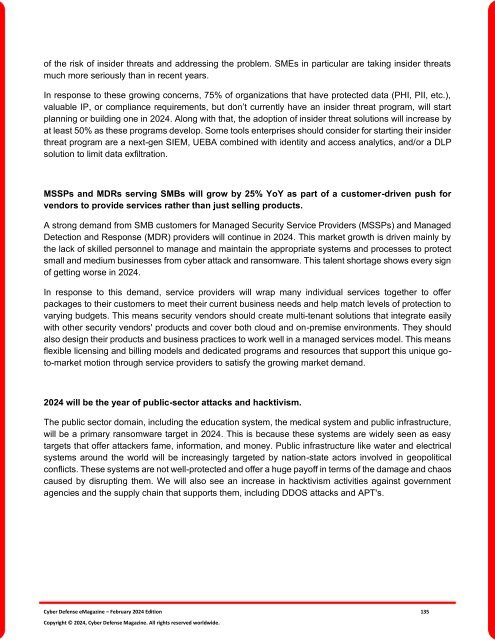The Cyber Defense eMagazine February Edition for 2024
Cyber Defense eMagazine February Edition for 2024 #CDM #CYBERDEFENSEMAG @CyberDefenseMag by @Miliefsky a world-renowned cyber security expert and the Publisher of Cyber Defense Magazine as part of the Cyber Defense Media Group as well as Yan Ross, Editor-in-Chief and many more writers, partners and supporters who make this an awesome publication! 155 page February Edition fully packed with some of our best content. Thank you all and to our readers! OSINT ROCKS! #CDM #CDMG #OSINT #CYBERSECURITY #INFOSEC #BEST #PRACTICES #TIPS #TECHNIQUES
Cyber Defense eMagazine February Edition for 2024 #CDM #CYBERDEFENSEMAG @CyberDefenseMag by @Miliefsky a world-renowned cyber security expert and the Publisher of Cyber Defense Magazine as part of the Cyber Defense Media Group as well as Yan Ross, Editor-in-Chief and many more writers, partners and supporters who make this an awesome publication! 155 page February Edition fully packed with some of our best content. Thank you all and to our readers! OSINT ROCKS! #CDM #CDMG #OSINT #CYBERSECURITY #INFOSEC #BEST #PRACTICES #TIPS #TECHNIQUES
You also want an ePaper? Increase the reach of your titles
YUMPU automatically turns print PDFs into web optimized ePapers that Google loves.
of the risk of insider threats and addressing the problem. SMEs in particular are taking insider threats<br />
much more seriously than in recent years.<br />
In response to these growing concerns, 75% of organizations that have protected data (PHI, PII, etc.),<br />
valuable IP, or compliance requirements, but don’t currently have an insider threat program, will start<br />
planning or building one in <strong>2024</strong>. Along with that, the adoption of insider threat solutions will increase by<br />
at least 50% as these programs develop. Some tools enterprises should consider <strong>for</strong> starting their insider<br />
threat program are a next-gen SIEM, UEBA combined with identity and access analytics, and/or a DLP<br />
solution to limit data exfiltration.<br />
MSSPs and MDRs serving SMBs will grow by 25% YoY as part of a customer-driven push <strong>for</strong><br />
vendors to provide services rather than just selling products.<br />
A strong demand from SMB customers <strong>for</strong> Managed Security Service Providers (MSSPs) and Managed<br />
Detection and Response (MDR) providers will continue in <strong>2024</strong>. This market growth is driven mainly by<br />
the lack of skilled personnel to manage and maintain the appropriate systems and processes to protect<br />
small and medium businesses from cyber attack and ransomware. This talent shortage shows every sign<br />
of getting worse in <strong>2024</strong>.<br />
In response to this demand, service providers will wrap many individual services together to offer<br />
packages to their customers to meet their current business needs and help match levels of protection to<br />
varying budgets. This means security vendors should create multi-tenant solutions that integrate easily<br />
with other security vendors' products and cover both cloud and on-premise environments. <strong>The</strong>y should<br />
also design their products and business practices to work well in a managed services model. This means<br />
flexible licensing and billing models and dedicated programs and resources that support this unique goto-market<br />
motion through service providers to satisfy the growing market demand.<br />
<strong>2024</strong> will be the year of public-sector attacks and hacktivism.<br />
<strong>The</strong> public sector domain, including the education system, the medical system and public infrastructure,<br />
will be a primary ransomware target in <strong>2024</strong>. This is because these systems are widely seen as easy<br />
targets that offer attackers fame, in<strong>for</strong>mation, and money. Public infrastructure like water and electrical<br />
systems around the world will be increasingly targeted by nation-state actors involved in geopolitical<br />
conflicts. <strong>The</strong>se systems are not well-protected and offer a huge payoff in terms of the damage and chaos<br />
caused by disrupting them. We will also see an increase in hacktivism activities against government<br />
agencies and the supply chain that supports them, including DDOS attacks and APT's.<br />
<strong>Cyber</strong> <strong>Defense</strong> <strong>eMagazine</strong> – <strong>February</strong> <strong>2024</strong> <strong>Edition</strong> 135<br />
Copyright © <strong>2024</strong>, <strong>Cyber</strong> <strong>Defense</strong> Magazine. All rights reserved worldwide.

















